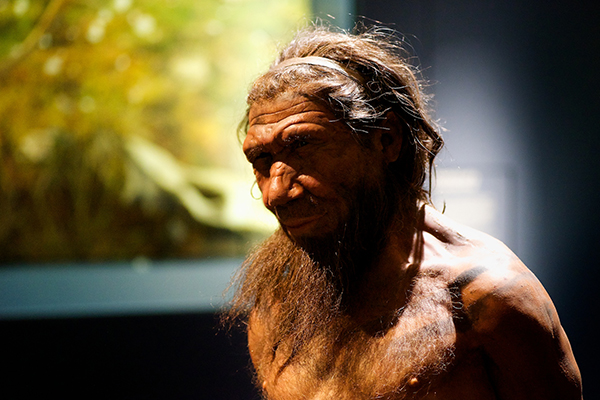
by Josh Knackert Wednesday, December 7, 2016

A reconstruction of a Neanderthal stands at the Natural History Museum in London. Genetic traces of Neanderthals and Denisovans have been identified in the DNA of modern humans. Credit: Paul Hudson, CC BY 2.0
You could have your mother to blame for a predisposition to baldness, but you might need to thank a Neanderthal for your ability to fight off disease. In the past decade, researchers have identified a number of genes in the human genome that they believe originated in Homo sapiens’ close evolutionary kin, Neanderthals and Denisovans. Now, a study published in the journal Molecular Biology and Evolution has identified additional traces of such archaic genes in modern human DNA.
Neanderthals lived in Europe and western Asia between about 400,000 and 40,000 years ago; less is known about Denisovans, which have been identified from DNA studies as well as from a few scattered fossils found in Asia that date to about 40,000 years ago. In the study, researchers identified genes that were inserted, or introgressed, into human DNA as a result of interbreeding among Neanderthals and Denisovans and our ancestors. In a process called adaptive introgression, these genes, which likely each conferred some advantageous trait, were then propagated through the genome via positive natural selection.
“Previous studies of this nature were rather straightforward, primarily focused on the frequency of archaic genes in modern human DNA,” says Joshua Akey, a genomicist at the University of Washington who was not involved in the study. “This study provides a more sophisticated simulation that considers how these genes may have persisted in the genome if they conferred advantages to human ancestors.”
Based on genes previously identified as having likely been passed down through adaptive introgression from Neanderthals and Denisovans, Emilia Huerta-Sánchez, a population geneticist at the University of California, Merced, and her colleagues identified genetic signatures in humans — long regions of genome — that are highly similar to the genomes of these archaic hominins. They used these signatures to develop statistical methods and computer simulations to search for genes not previously associated with adaptive introgression in a database of 1,000 modern human genomes.
“While only 2 percent of genes [in modern humans] on average show archaic signatures, the affected genes are concentrated in some very functional regions of the genome,” Huerta-Sánchez says. The majority of both new and previously highlighted genes identified in the new study are involved in functions such as lipid metabolism, which could potentially affect body fat distribution; pigmentation, including the ability of skin cells to react to ultraviolet radiation; and innate immunity.
Genetic advantages in these regions of the genome would have helped modern humans migrating out of Africa survive new challenges in Europe and Asia, like bitter cold and novel pathogens, Huerta-Sánchez and her colleagues noted in the study. “Neanderthals and Denisovans had been living in these regions for hundreds of thousands of years, so it makes sense that they had adapted better genetic mechanisms for coping with these challenges,” Akey says. “Receiving large portions of DNA from native hominins would have the potential for instilling a number of beneficial mutations into modern humans far faster than natural selection alone.”
Improved statistics and simulations are important for identification of adaptive introgression and building a better understanding of its effect on human evolution, Huerta-Sánchez says. She and her colleagues also suggested several topics that need to be considered in future studies, including accounting for multiple gene-mixing events between modern humans and other hominins; more accurately defining genetic subpopulations like Native Americans; and determining whether genes affected by adaptive introgression actually conferred benefits or simply muted deleterious genes that were already present.
Beyond improving our understanding of human evolution, the new research could also impact what we know about the evolutionary histories of other animals. “Adaptive introgression is likely widespread in other species, so making it easier to identify [introgressed genes] may increase our understanding of their evolution,” Huerta-Sánchez says.
Dogs might make a logical next target for such work as their evolution is already relatively well understood, Akey says. He says he is cautiously optimistic about the prospect: “In terms of species evolution, we know much more about humans, making it easier to map adaptive introgression [in our own lineage] compared to other species. However, this may be a rare case where human genetics help us understand the evolution of lesser species instead of the other way around.”
© 2008-2021. All rights reserved. Any copying, redistribution or retransmission of any of the contents of this service without the expressed written permission of the American Geosciences Institute is expressly prohibited. Click here for all copyright requests.